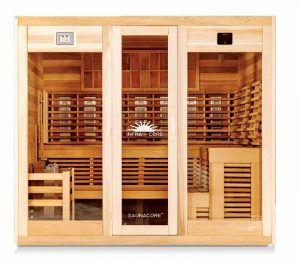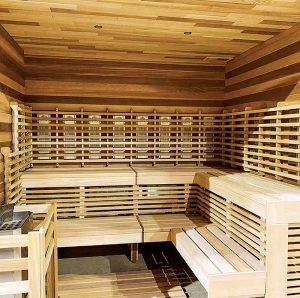Exploring the phenomenal rise in demand for saunas
by arslan_ahmed | February 16, 2024 10:00 am
 [1]
[1]By Anna Vetta
Demand of saunas have gained unprecedented popularity, prompting some to ponder the reasons behind their surge, while others question why it took so long for their widespread recognition.
Saunas have been a growing wellness commodity for spas, gyms, yoga studios, hotels and resorts, and many more commercial locations for years. Saunas in homes have also been increasing in demand, especially over the past two years, which has been a whirlwind.
Amid the global pandemic, saunas emerged as a greatly sought-after wellness product, and these trends in demand appear to be enduring. Before delving into this transformative shift, it is important to understand some essential elements about saunas. The following explores these various areas.
History of saunas
The origins of the sauna can be traced back to more than 2,000 years ago in Finland. A sauna was simply a wood room or a stone temple with a hole in the dirt (referred to as a “pit”), and it was filled with wood fire. Finns would use the sauna for many daily activities—from eating meals, social gatherings, to as a relaxation space. The ritual of birthing would also take place in the sauna, in addition to new mothers using the space for resting.
Sauna rooms were made of stone, brick, and most commonly wood. A wood structure for either interior or exterior is the perfect material choice for any sauna design. Later, heat sources evolved and many options became available. With the gaining awareness of the benefits of saunas, they then became the “must-have” item for almost every home in Finland.
From the author’s standpoint, the use of saunas is deeply ingrained in Finnish culture. In this nation with a population of 5.5 million, the prevalence of saunas is comparable to that of television sets, totalling approximately 3.3 million. About two decades ago, during the author’s business and leisure travels, a trip to Finland highlighted the fascinating observation that households in the country might possess more saunas than cars.
The author found this phenomenon intriguing, yet did not completely comprehend why Finns believed households should have at least one sauna, with many opting for two. Was it a necessity or a preference? The author sought an answer, only to receive the response, “Us Finns love our saunas!” Despite the vague reply, the author considered this piece of valuable information for sauna enthusiasts. Twenty years later, the question lingered: would the author and the rest of the world come to fully understand it, too?
 [2]
[2]Types of saunas
There are many heat source options available for saunas, from hot rock to infrared, to steam.
Wood-burning saunas
As mentioned, saunas began as a fire pit, but this is not common anymore as a wood-burning stove, fired by wood, has now replaced the traditional fire pit. Wood-burning saunas are great options for any outdoor saunas and cottage living. There are options to have the wood stove stoked from interior or exterior.
Interior stoke will allow the user to bring wood inside the sauna and feed it. Exterior stoke will allow the convenience of filling the wood chimney from outside the sauna, creating less mess within the sauna, but keeping in mind that the user will have to step outside to refill each time. The choice become the client’s preference as both options offer separate benefits.
Some wood stoves also have optional add-ons of a water tank or a rock cage for a more industrial feel, which is a popular style for camps. Wood stove fired saunas are popular in areas where electric is remote or expensive.
Traditional electric saunas
Electric sauna stoves, often referred to as a “traditional sauna with rocks,” are quite popular and perhaps the most popular for many commercial spaces. Gyms and hotels have had traditional saunas for many years, as this added service to any gym or spa allows users to reap the many benefits of a sauna in a large communal setting.
Sauna electric heaters are both convenient and offer a wide range of kilowatt sizes, voltage options, and control upgrades, making these heaters of the most popular saunas styles of the past and of today. These traditional electric saunas have minimal maintenance, as there is no need to cut and fill wood and there will be no soot to cleanup. These saunas include a safety feature as the controls for the electric stove/heater include an automatic shutoff. The automatic shut off feature is an added benefit, since with a wood-burning sauna, it is important to ensure fire is put out first.
This convenience has now opened many doors for sauna enthusiasts, as the sauna is no longer only an exterior structure, leading to the demand of indoor saunas. Now, these traditional saunas (available indoor or outdoor) also allow users to pour water onto the rocks for added humidity. With colder months, adding sauna essences to the water-filled bucket will add benefits to aid with colds and flu-like symptoms. It was a win-win for anyone wanting to better their wellness; a sauna that can be used year-round, be it indoor or outdoor.
 [3]
[3]Infrared saunas
An infrared sauna is not a “hot sauna” (although some may argue otherwise). It is more of a soothing warm sauna with no water. One may wonder, why is it called a sauna? This is primarily because the benefits of heat in a wood room may be compared to the same benefits of infrared saunas. More so, infrared saunas present a more comfortable heat and penetrate the body directly, whereas traditional saunas, which heat up the room and users perspire when the room is hot.
Infrared saunas offer enjoyment for individuals who prefer a milder experience, finding traditional saunas too hot. With an infrared sauna, they can still reap the benefits without enduring intense heat. When communicating with clients, one can draw a comparison between saunas and a hot summer day. Traditional saunas represent the scorching heat of 2 p.m. sunlight, while infrared saunas provide a sensation akin to sitting in the shade under a large willow tree. The comforting warmth characterizes the experience of an infrared sauna. With three sauna options now available, there is a choice to meet everyone’s needs.
Dual saunas
Dual saunas are the best of both worlds in one room. A dual sauna is both infrared, a traditional sauna (e.g. hot stone heater) in one room. With these, users may enjoy that metaphor of both an intense 2 p.m. sun and/or escape to the shade. This sauna is one of the most popular on the market, as it allows clients confused between which sauna to purchase to make an easy choice.
Steam rooms
Steam rooms, unlike sauna rooms that are finished in wood, are rooms finished in tile, glass, marble, etc., (i.e. a non-porous material, similar to a shower.) The steam room is also referred to as a “hammam spa,” which is a room with high humidity and steam. Some people also refer to this as a “wet sauna.”
Some steam rooms are solely steam rooms, while others have a combined steam room and shower space. This is great option to use a shower space and convert into a steam room for added ambiance and benefits.
The versatility of saunas
The variety of saunas to choose from are plentiful. With a sauna manufacturer, the design and size possibilities for a sauna enthusiast are achievable. If there is no space outside for a sauna, then inquire for an indoor sauna. No space is too small, and no space is too large for a sauna.
If there is no space inside a house, consider an outdoor sauna. Is electrical an issue for an outdoor sauna? Outdoor saunas have a wood burning option for a remote cottage life or near the lake, where electrical is not possible. Looking for an energy efficient sauna? Some models are the perfect fit. Did you know some saunas also come in plug-and-play forms? An ideal spot for a sauna room can be in the basement, bedroom, or bathroom.
 [4]
[4]What if standard sauna models just do not fit the space? Inquire with a North American sauna manufacturer to customize a sauna made just for the user. They can be made to the exact size to fit any space, be it a commercial gym, yoga studio, hotel, or a house. Does the client require a specific wood type? This is possible, too. With countless possibilities, a sauna manufacturer can make a vision come to life.
The benefits of saunas
The benefits of saunas vary and in a wide range. From relaxation, improving heart conditions, to ridding flu-like symptoms; the sauna has been a-go to for aiding many ailments for years.
Sauna benefits include reduction in the risk of vascular diseases such as high blood pressure, cardiovascular disease, and neurocognitive disease: nonvascular conditions such as pulmonary diseases, as well as arthritis, headache, and flu.
Sauna users also enjoy the conditioning of the body’s muscles from aches and pains. Increased endorphins while sauna bathing allow one to reduce their stress levels and reduce pain. (Endorphins are polypeptides made by the pituitary gland and central nervous system.)
While endorphins are doing their job of increasing in a sauna, serotonin also increases. Low levels of serotonin allow for depression. Serotonin is the “happy hormone,” and it affects mood and behaviour in a positive way. Increased levels of serotonin and lowering levels of cortisol (stress hormone) are one of many benefits of saunas.1
Another benefit is burning calories. According to the U.S. Army medical research (Ward Dean, M.D.), “A moderately conditioned person can easily sweat off 500 grams [17.6 oz] in a sauna in a single session, consuming nearly 300 calories in the process.”
Other positives from sauna bathing include sharpening of one’s senses, beautifying the skin, revitalizing the mind and body, and overall escape of the realities of daily life it offers. However, one is still recommended to consult their physician before any sauna use, particularly health use.
Exploring the history, types, options, and benefits of saunas, the narrative now transitions to an examination of why saunas have become one of the hottest commodities on the worldwide market.
 [5]
[5]Becoming a hot commodity
During the pandemic, saunas became one of the most in-demand wellness products by consumers, a trend that appears here to stay.
Saunas witnessed a surge in popularity within various commercial spaces, but the pandemic prompted individuals to transform their homes into personal retreats and wellness sanctuaries. With travel on the decline, staycations gained traction. And what better staycation than having a sauna conveniently at home, ready for use at any time of the day?
The popularity of home saunas saw a notable rise, surprising the author who initially doubted that the Finnish lifestyle of having more saunas than cars in a household would translate to North America. However, clients began to order two or three saunas, acquiring one for their home interior, another for the backyard by the pond, and yet another for their cottage. The author was impressed to witness individuals who had never contemplated saunas now purchasing multiple units at a time.
With more time at home, individuals researched online, particularly exploring the benefits of saunas. The author explained to one client, “Heat lifts, it lifts dirt from a counter, just as heat from a sauna lifts toxins from the body.” People engaged in frequent research, realizing that saunas not only eliminate toxins but also elevate one’s spirits. During the pandemic, activating one’s spirit, or the “happy hormone” (serotonin), became essential for many.
Individuals found the concept of customizable saunas to meet their design preferences intriguing, marking a significant shift in perspective. The revelation that saunas are energy-efficient further captivated them. In addition, discovering the availability of sauna types catering to both those who prefer higher temperatures and those who prefer milder ones left them amazed.
Saunas evolved into a personal indulgence or a thoughtful present for others—a gift symbolizing relaxation, an at-home spa experience, a gesture of wellness, or even a means to shed those extra pounds gained during COVID. Regardless of the specific purpose, saunas have undeniably secured a spot on people’s priority lists today and in the days to come.
Heightened awareness led people to comprehend what the Finns had known all along: saunas hold more significance than TVs and cars. Saunas become integral to one’s way of life, and when individuals incorporate saunas into their lifestyle, the benefits become exponential.
Notes
1 Consult the report, Cardiovascular and Other Benefits of Sauna Bathing, by Jari.ALaukkanen. For more information, visit www.mayoclinicproceedings.org/article/S0025-6196(18)30275-1/fulltext[6].
References
- Refer to “The Sauna” by Rob Roy, published by Chelsea Green Publishing Company.
- Learn more by reading “Some Like It Hot: Get Yourself In A Sauna” by LLM Reporters.
 Author
Author
Anna Vetta is the sales administrator for Saunacore, a manufacturer of custom sauna products in Bolton, Ont. She has more than 15 years’ experience in the sauna industry and holds a specialist degree in economics and geography from the University of Toronto. Vetta can be reached via e-mail at anna@saunacore.com.
- [Image]: https://www.poolspamarketing.com/wp-content/uploads/2024/02/sauna_Couple.jpg
- [Image]: https://www.poolspamarketing.com/wp-content/uploads/2024/02/SAUNAS_SAUNACORE-CUSTOM-6X8-DUAL-SAUNA.jpg
- [Image]: https://www.poolspamarketing.com/wp-content/uploads/2024/02/SAUNAS_Custom-Dual-sauna-with-custom-upgrade.jpg
- [Image]: https://www.poolspamarketing.com/wp-content/uploads/2024/02/SAUNAS_Dual-custom-sauna-heater-and-infrared.jpg
- [Image]: https://www.poolspamarketing.com/wp-content/uploads/2024/02/dreamstime_l_253657702.jpg
- www.mayoclinicproceedings.org/article/S0025-6196(18)30275-1/fulltext: https://www.mayoclinicproceedings.org/article/S0025-6196(18)30275-1/fulltext
Source URL: https://www.poolspamarketing.com/trade/features/exploring-the-phenomenal-rise-in-demand-for-saunas/